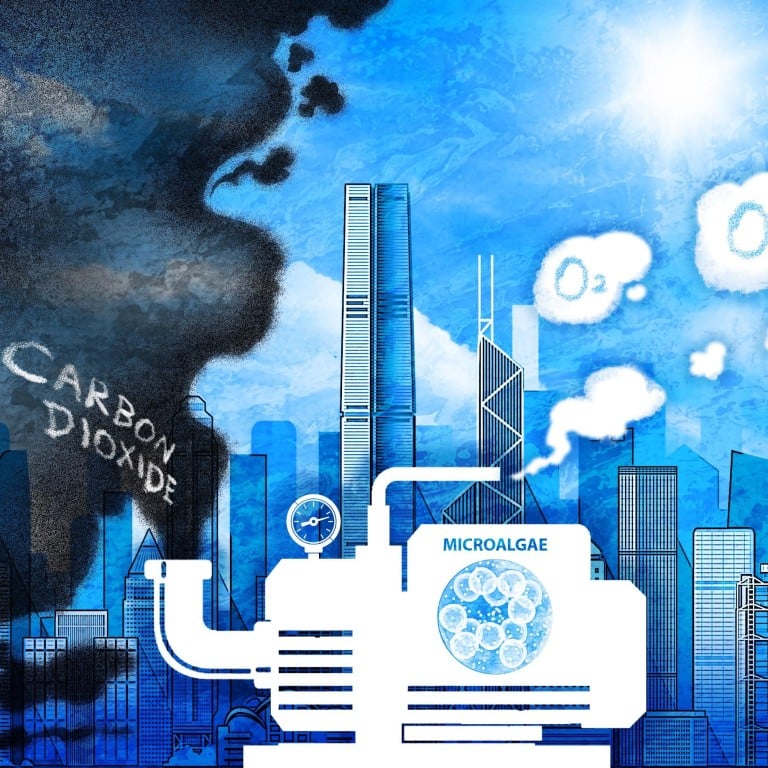
Green innovation: Hong Kong start-ups nurture trillions of tiny algae as carbon-capture tech to address climate change
- Firms worldwide, including in Hong Kong, are racing to show that farming microalgae can be a cost-effective form of carbon capture and storage
- While the potential is real, reaching a sufficient scale and the low cost of carbon-removal credits remain as major challenges
On a small plot of farmland in Hong Kong’s western New Territories, just across the border from mainland China, a series of pumps directs agricultural waste water from a nearby river into a row of outdoor tanks, providing nutrients for trillions of green microalgae.
The facility is not growing the tiny plants as a crop, but rather for their ability to help solve one of the world’s most pressing issues by absorbing carbon dioxide.
“How they capture carbon dioxide is through photosynthesis,” said Nelson Ng Pok-him, co-founder and CEO of Alcarbo Technologies. “They turn carbon dioxide into something like sugar … and they store it inside their bodies. They are like little carbon-dioxide containers.”
Most plant life on the planet does the same thing, producing oxygen and energy for its own use in the process. But microalgae have a prodigious capacity for carbon dioxide relative to their mass, which is why Alcarbo – and many competitors – are racing to demonstrate that microalgae operations can scale up sufficiently to become a cost-effective carbon-capture solution and help reduce human-induced climate change.
Alcarbo’s team of six set up the facility on a 150-square-metre patch in San Tin in the Yuen Long district over five months in early 2023. The site houses two shipping containers that contain algae cultivation and harvesting equipment, as well as a water filtering system – all powered by solar panels. Nearby is a “wall” of 12 algae photobioreactors, which are capable of absorbing half a tonne of carbon dioxide a year even after factoring in the carbon footprint of electricity consumption and construction, Ng said.
“But it can do much better than that,” Ng said, because adding more capacity increases the carbon-absorbing capacity without significantly adding to the carbon footprint. “When we scale it up we just have to build more reactors.”
Countries and companies around the world have pledged to reduce their carbon emissions in line with commitments to limit global warming, and innovative solutions including the use of algae to capture carbon dioxide are emerging to help reach those goals.
Countries must deliver on climate agreements they have signed: Johan Rockstrom
A tonne of microalgae absorbs around two tonnes of carbon dioxide while releasing 1.3 tonnes of oxygen as it grows, according to ENN.
ENN launched a research and development project for microalgae carbon absorption in 2007, aiming to prove the technology’s potential on an industrial scale.
Since then, ENN has built a microalgae demonstration base with a total area of more than three acres on desert land in Dalad Banner in Ordos in Western Inner Mongolia.
For Alcarbo, Hong Kong has proved to be a good base of operations, so far.
“It’s a good demonstration place,” Ng said. “For research and development it’s a really good place. It’s also good for us to showcase our proof-of-concept to people from all over the world so they can see that this is really working.”
China’s new energy efficiency target could endanger 2025 climate commitments
Alcarbo has received HK$2.6 million (US$332,000) in funding from Hong Kong Science and Technology Parks (HKSTP), City University of Hong Kong’s HK Tech 300 fund and the Hong Kong Polytechnic University’s Micro Fund.
The company hopes to scale its capacity up to 100 tonnes a year by next year. That would require 2,900 bioreactors spanning 3,500 square metres, around half the size of a professional football stadium, including a water storage tank and a filtering system. Such a facility would absorb carbon dioxide equivalent to 90,000 square metres of forest, or around 13 football pitches.
“For scale-up, I think we need to find other places, as the rent and the labour in Hong Kong is too expensive,” Ng said. Potential locations include mainland China, Vietnam, Pakistan and the Middle East.
“We hope to have our carbon capture sites in different regions around the world, to at least capture the emissions that we are producing,” he said.
Alcarbo is not the only start-up in Hong Kong using microalgae as a decarbonisation solution.
Another, AlGreen, combines carbon capture and air purification in one system. It is reaching out to companies and public institutions in hopes of achieving deployment this year, said Rehaan Lulla, co-founder and chief technology officer.
The company was admitted to the HKSTP incubation programme in May 2022, and has received HK$420,000 in funding after passing three milestone assessments.
The start-up plans to implement a 1,000-litre bioreactor that uses only solar power to operate later this year.
Transition finance seen as a crucial tool in the fight against climate change
“AlGreen is currently exploring pilot-scale opportunities in Hong Kong as well as the Greater Bay Area, which is a slight challenge,” Lulla said. “Hong Kong and Greater Bay Area cities do share similar climate patterns, allowing for parallel microalgae growth patterns if our technology is to be reproduced in the Greater Bay Area.”
Before all this is possible, AlGreen must reproduce its laboratory results on a pilot scale, which would be “greatly enhanced with local strategic partnerships”, Lulla said.
The major problem for microalgae as a carbon-capture technology is harvesting, which requires expensive facilities, said Li Ning, professor of the division of life science at Hong Kong University of Science and Technology.
“There are so many different types of microalgae production systems around the world,” he said. “Most of them are used for research and education purposes rather than for commercial purposes. That means that these systems are expensive and not economically viable, especially for carbon-dioxide fixation purposes.”
International firms working on microalgae as a means for decarbonisation include London-based start-up Brilliant Planet, which aims to remove carbon dioxide from the atmosphere by growing local strains of marine algae on land in coastal desert areas.
“The business originally focused on marine microalgae for the production of animal feed stock,” said Piers Mudd, Brilliant Planet’s chief operating officer. “Studies into the power of photosynthesis and the study of carbon-rich algal species then saw the business pivot to focus on carbon.”
Brilliant Planet’s facilities can capture 30 times more carbon per year than an equivalent area of forest, without competing for productive land, the company said.
In July, Brilliant Planet announced that it would remove 1,500 tonnes of carbon by 2027 at its planned demonstration facility in Morocco for global technology company Block.
Block bought desert algae carbon removal from Brilliant Planet through the Watershed Marketplace, an enterprise climate platform that allows companies to buy carbon removal options.
Brilliant Planet is currently operating a five-hectare pilot facility and intends to build its first commercial facility in 2027, capable of removing around 25,000 tonnes of carbon dioxide per year. By 2030 the company aims to be removing 1 million tonnes a year.
However, that is still a drop in the ocean compared to the 37.4 gigatonnes of carbon-dioxide the world emitted just last year from the production of energy alone, according to the International Energy Agency.
Limiting global warming to the key 1.5 degrees Celsius threshold above pre-industrial levels will require the removal of hundreds of billions of tonnes of carbon dioxide over the 21st century, and carbon-capture technologies will form a crucial part of such efforts, according to the UN Intergovernmental Panel on Climate Change.
However, concerns exist over nature-based solutions such as algae, according to Standard Chartered’s global research report “Seaweed: Kelp is on the way” published on October 31.
One is “additionality”, which refers to whether the removal of greenhouse-gas emissions would have happened without the nature-based solution. Another is permanence: whether the emissions are removed and stored for 25 years or more. Finally, there is the risk of double counting, which occurs when two or more holders claim the same carbon-removal credit.
ENN has also experimented with different product lines for the microalgae it produces. Adding microalgae into chicken feed, it has produced its Aiyowe branded eggs, which claim to offer nutritional benefits over ordinary eggs, including vitamins and increased fatty acids. The high-end eggs have been sold in mainland markets including Beijing and Shanxi.
Alcarbo’s Ng said microalgae can also be used as a raw material in biofuels, supplements and cosmetics. But he is also well aware that his company’s future depends on the price of carbon-removal credits – the company’s main product – rising significantly.
“This is a long-term investment, as the price of carbon credits is currently not so high,” he said. “But when our technology is developed, we can sell our carbon credits when carbon credits are priced higher. Revenues at that time will be very good.”


